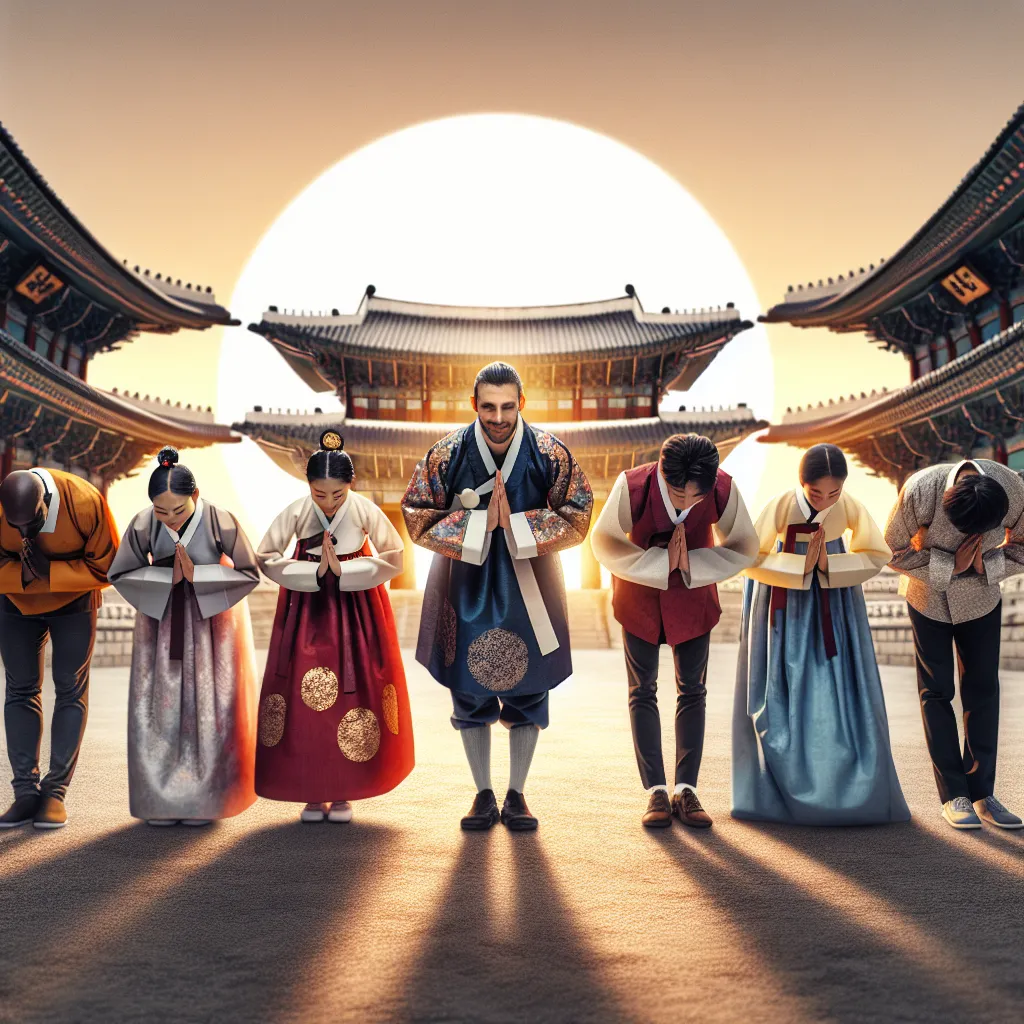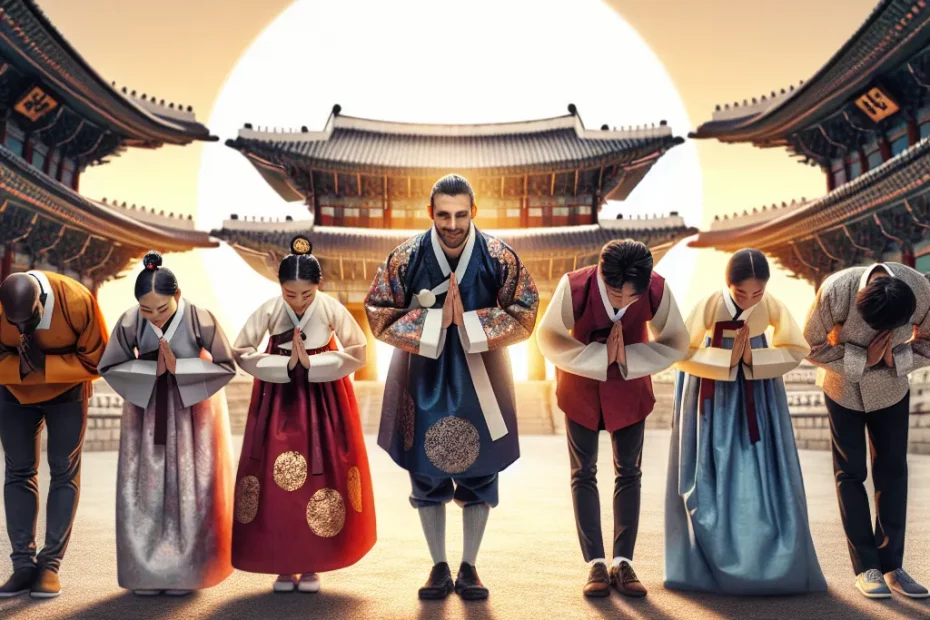As we delve into the rich cultural tapestry of Korea, one cannot ignore the profound significance of bowing in Korean society. Bowing is not just a simple gesture, but a deeply ingrained tradition that reflects respect, humility, and etiquette. Understanding the proper way to bow in Korea is essential to show reverence and courtesy in various social interactions. Let’s explore the cultural importance, different types of bows, proper etiquette, and common mistakes to avoid when bowing in Korea. So, let’s bow our heads in curiosity and respect as we embark on this enlightening journey into the art of bowing in Korea.

The Cultural Importance of Bowing
Bowing is not just a simple gesture; it holds a significant cultural importance in Korean society. So, let’s explore why bowing is so crucial and how to do it properly to show respect and courtesy.
The Significance of Bowing in Korean Culture
In Korean culture, bowing is a traditional way of showing respect, gratitude, and humility. It is deeply ingrained in the social norms and is considered a fundamental aspect of interpersonal relationships. The angle and depth of the bow can convey different meanings, such as a casual greeting, a formal apology, or a profound show of respect.
Did you know that there are different types of bows in Korea? The most common ones include the informal bow (30 degrees), the formal bow (45 degrees), and the deep bow (90 degrees). Each type of bow is used in specific situations, depending on the level of respect or formality required. So, mastering the art of bowing is essential for navigating various social interactions in Korea.
Bowing is not just about bending your body; it reflects your attitude and sincerity towards the person you are bowing to. It is a non-verbal way of communicating respect and acknowledging the other person’s presence. So, the next time you find yourself in a situation where bowing is appropriate, remember to do it with sincerity and grace.
The Role of Bowing in Maintaining Harmony
In Korean culture, the act of bowing is also a way to maintain harmony and balance in relationships. It is a way to show appreciation for others and to express humility. By bowing, individuals demonstrate their understanding of hierarchy and social order, fostering a sense of unity and respect within the community.
So, whether you are visiting Korea or interacting with Korean individuals, understanding the cultural significance of bowing is essential. By mastering the art of bowing and practicing it with sincerity, you can show respect, build rapport, and create positive connections with others in Korean society.
In conclusion, bowing is not just a physical gesture; it is a profound symbol of respect, humility, and harmony in Korean culture. So, let’s embrace this beautiful tradition and bow with sincerity and grace to show our appreciation for others. Remember, a simple bow can speak volumes and create lasting impressions in the hearts of those around you. Keep bowing, keep respecting, and keep spreading positivity wherever you go! 🙇🇰🇷
Different Types of Bows in Korean Culture
Hey there, curious minds! Let’s dive into the fascinating world of Korean culture and explore the various types of bows that hold significant meaning in this vibrant society. 🇰🇷
The “Eshin” Bow
In Korea, bowing is not just a simple gesture; it is a form of communication, respect, and tradition deeply rooted in the country’s history. The depth of the bow, the angle, and the timing all convey different messages, making it a nuanced art form.
The “Kanshin” Bow
First up, we have the “Kanshin” bow, which is a casual and informal bow where the person simply nods their head slightly. This type of bow is commonly used among friends, colleagues, or when greeting someone quickly in passing. It’s a friendly gesture that shows acknowledgment and familiarity.
The “Keunjeol” Bow
Next, we have the “Keunjeol” bow, which is a more formal bow where the person bends at the waist about 15 degrees. This bow is often used in business settings, to show respect to elders, or in more formal social situations. It signifies a higher level of respect and politeness.
The “Yeoljeong” Bow
Moving on, we have the “Yeoljeong” bow, which is the deepest and most formal bow where the person bends at the waist to a 45-degree angle or even lower. This bow is reserved for very formal occasions, such as weddings, funerals, or when showing the utmost respect to someone in authority. It is a profound gesture of reverence and humility.
The “Yeoljeong” Bow
Lastly, we have the “Yeoljeong” bow, which is a bow of apology or deep gratitude. In this bow, the person bends at the waist to a 90-degree angle, showing extreme sincerity and remorse. It is a way to express deep regret or profound appreciation for someone’s kindness.
Each type of bow carries its own unique meaning and is used in specific contexts to convey different emotions and levels of respect. So, the next time you find yourself in Korea or interacting with Korean individuals, pay attention to the subtle art of bowing and appreciate the rich cultural significance it holds.
Remember, a bow is not just a physical gesture; it is a reflection of one’s heart and intentions. So, bow with sincerity and grace, and you’ll surely leave a positive impression wherever you go! 😉
Proper Etiquette When Bowing in Korea
Bowing is an essential part of Korean culture, reflecting respect, gratitude, and humility. Understanding the significance and proper way to bow is crucial when interacting with Koreans. In Korea, bowing is not just a simple gesture; it carries deep meaning and shows one’s sincerity and politeness.
The Angle of the Bow
The angle of the bow is significant in Korean culture. A slight bow, about 15 degrees, is appropriate for casual situations or when greeting friends. A deeper bow, around 30 degrees, is more suitable for showing respect to elders, superiors, or during formal occasions. The deepest bow, about 45 degrees, is reserved for special circumstances like apologizing or showing utmost respect, such as in a funeral setting.
Proper Body Posture
When bowing in Korea, it is essential to keep your back straight and your hands at your sides. Avoid crossing your arms or placing your hands in your pockets while bowing, as it can be seen as disrespectful. Additionally, maintaining eye contact during a bow is considered impolite, so it is customary to lower your gaze or look at the ground.
Timing and Duration
Timing is also crucial when bowing in Korea. When bowing to someone, the younger or lower-ranked person should initiate the bow, and the older or higher-ranked person should return the bow. It is essential to synchronize the timing of the bows to show mutual respect.
In Korean culture, the duration of the bow is also significant. A brief bow is appropriate for casual situations, while a more extended bow is suitable for formal or solemn occasions. The duration of the bow reflects the level of respect and sincerity you wish to convey.
Overall, bowing in Korea is a beautiful and meaningful gesture that symbolizes respect, gratitude, and humility. By understanding the proper etiquette when bowing, you can show your appreciation for Korean culture and build positive relationships with the people you encounter. Remember, a bow is not just a physical movement; it is a reflection of your sincerity and respect towards others. 🇰🇷🙇♂️🌟
Common Mistakes to Avoid When Bowing
When it comes to bowing in Korea, there are certain common mistakes that many people make without even realizing it. Understanding the significance and proper way to bow is crucial in Korean culture, so let’s delve into some of the key mistakes to avoid when bowing.
Not Bowing Deep Enough
First and foremost, one of the most common mistakes is not bowing deep enough. In Korea, the depth of your bow signifies the level of respect you are showing. A shallow bow may come across as insincere or disrespectful, so be sure to bow deeply, especially in formal settings.
Failing to Maintain Eye Contact
Another common mistake is failing to maintain eye contact during a bow. In Korean culture, maintaining eye contact during a bow is a sign of sincerity and respect. Avoiding eye contact can be seen as rude or disinterested, so remember to keep your eyes focused during the bow.
Bowing with Hands in Pockets
One more mistake to avoid is bowing with your hands in your pockets. This gesture is considered extremely disrespectful in Korea, as it shows a lack of sincerity and humility. Always keep your hands by your sides or clasped in front of you when bowing to show proper respect.
Rushing Through a Bow
Additionally, rushing through a bow is another mistake to steer clear of. A rushed bow can give off the impression that you are not taking the moment seriously or that you are insincere. Take your time, pause briefly at the bottom of your bow, and show that you are giving the gesture the proper respect it deserves.
Forgetting to Return a Bow
Lastly, forgetting to return a bow is a mistake that should be avoided at all costs. In Korean culture, it is customary to return a bow as a sign of mutual respect. Failing to do so can be seen as dismissive or impolite, so always remember to reciprocate a bow when it is given to you.
By being mindful of these common mistakes and practicing the proper way to bow in Korea, you can show respect and understanding of Korean culture in a meaningful way. Remember, bowing is not just a physical gesture, but a reflection of your sincerity and respect for others. So, bow deeply, maintain eye contact, keep your hands visible, take your time, and always remember to return a bow when it is given to you! 🙇♂️🇰🇷
Bowing is not just a simple gesture in Korean culture; it holds deep cultural significance and reflects respect, humility, and gratitude. Understanding the different types of bows and the proper etiquette when bowing is essential to show respect in Korean society. By avoiding common mistakes like improper posture or lack of sincerity, we can truly convey our respect to others. So, next time you find yourself in a situation where bowing is appropriate, remember the importance of this gesture and execute it with sincerity and grace. It’s not just a physical movement; it’s a way to show appreciation and respect to others.
